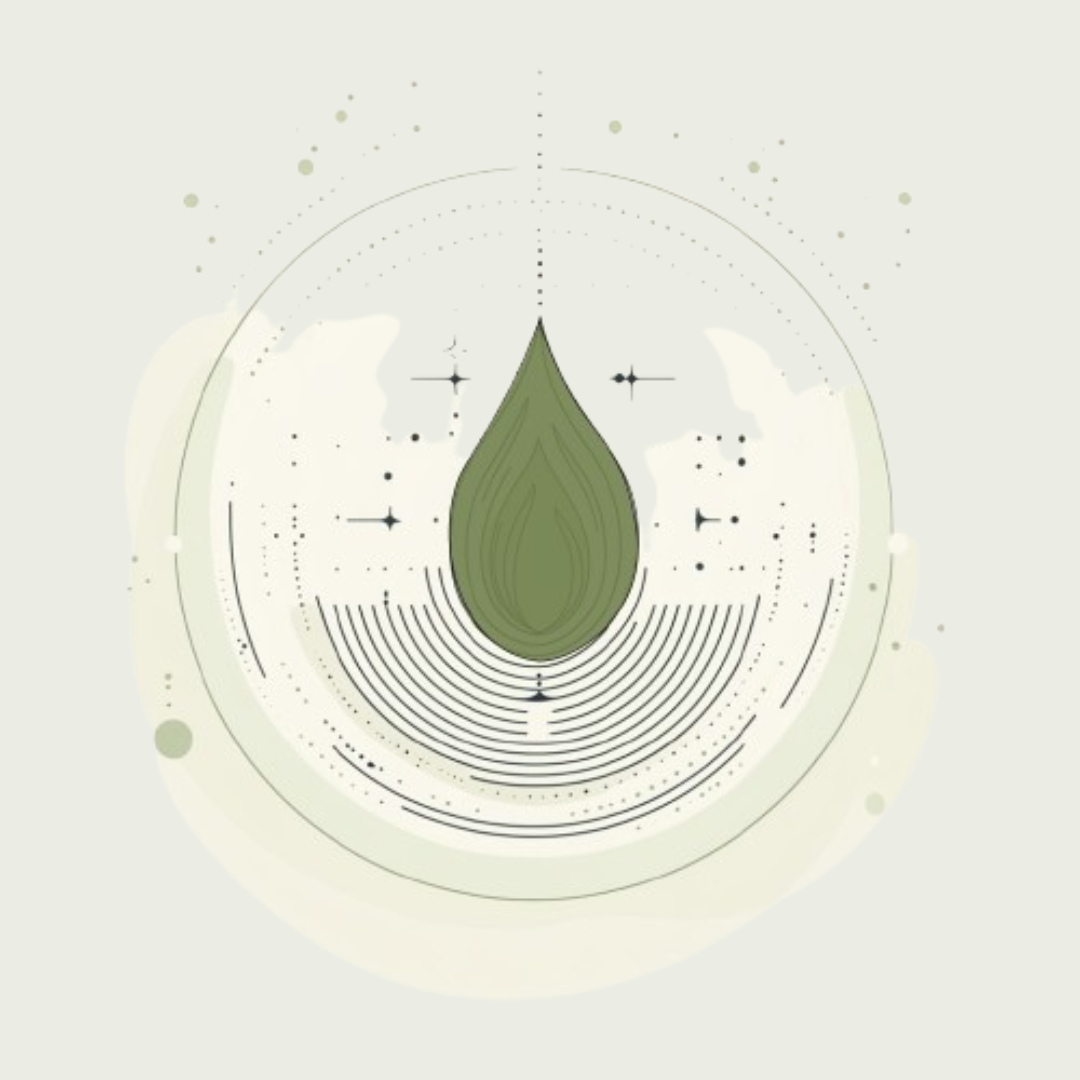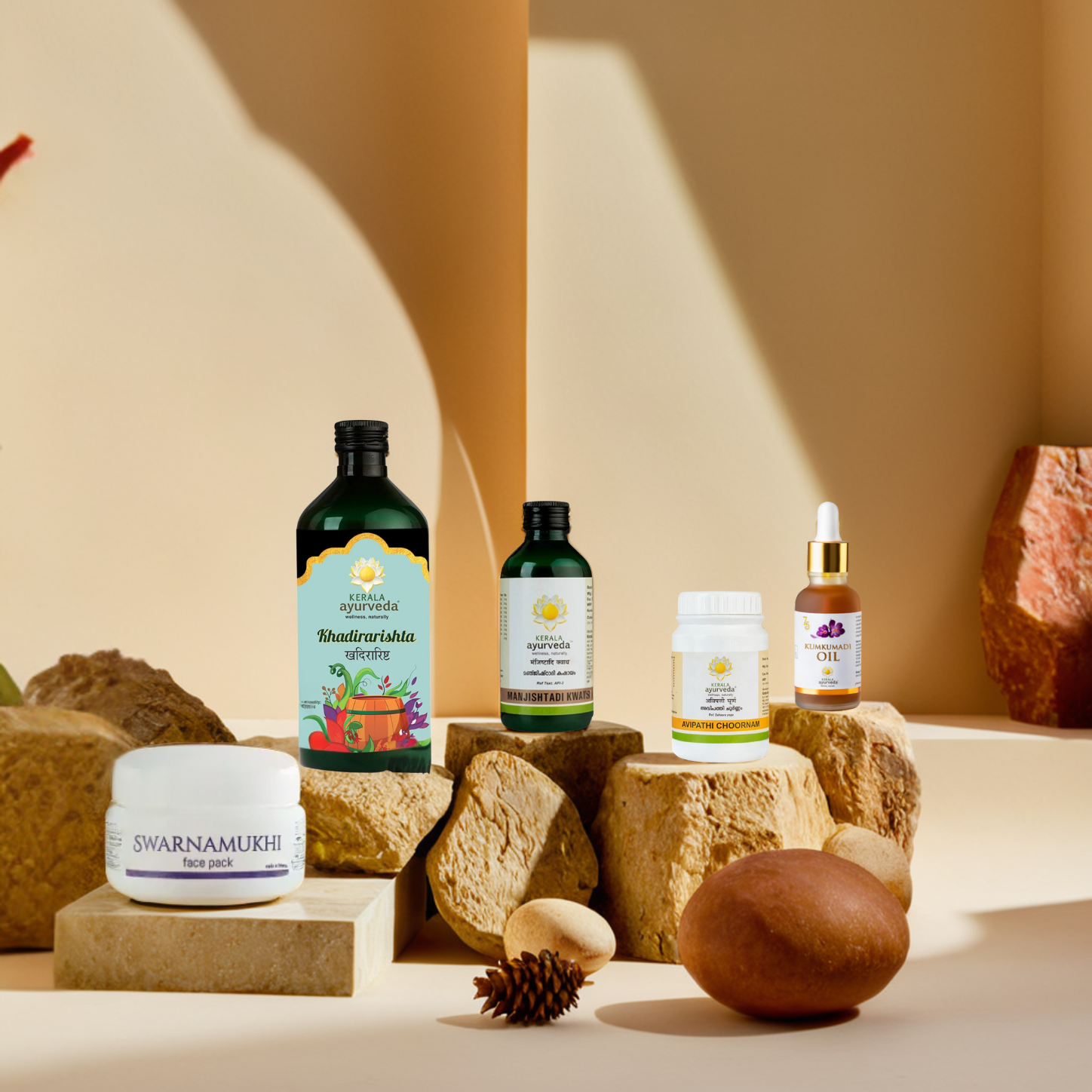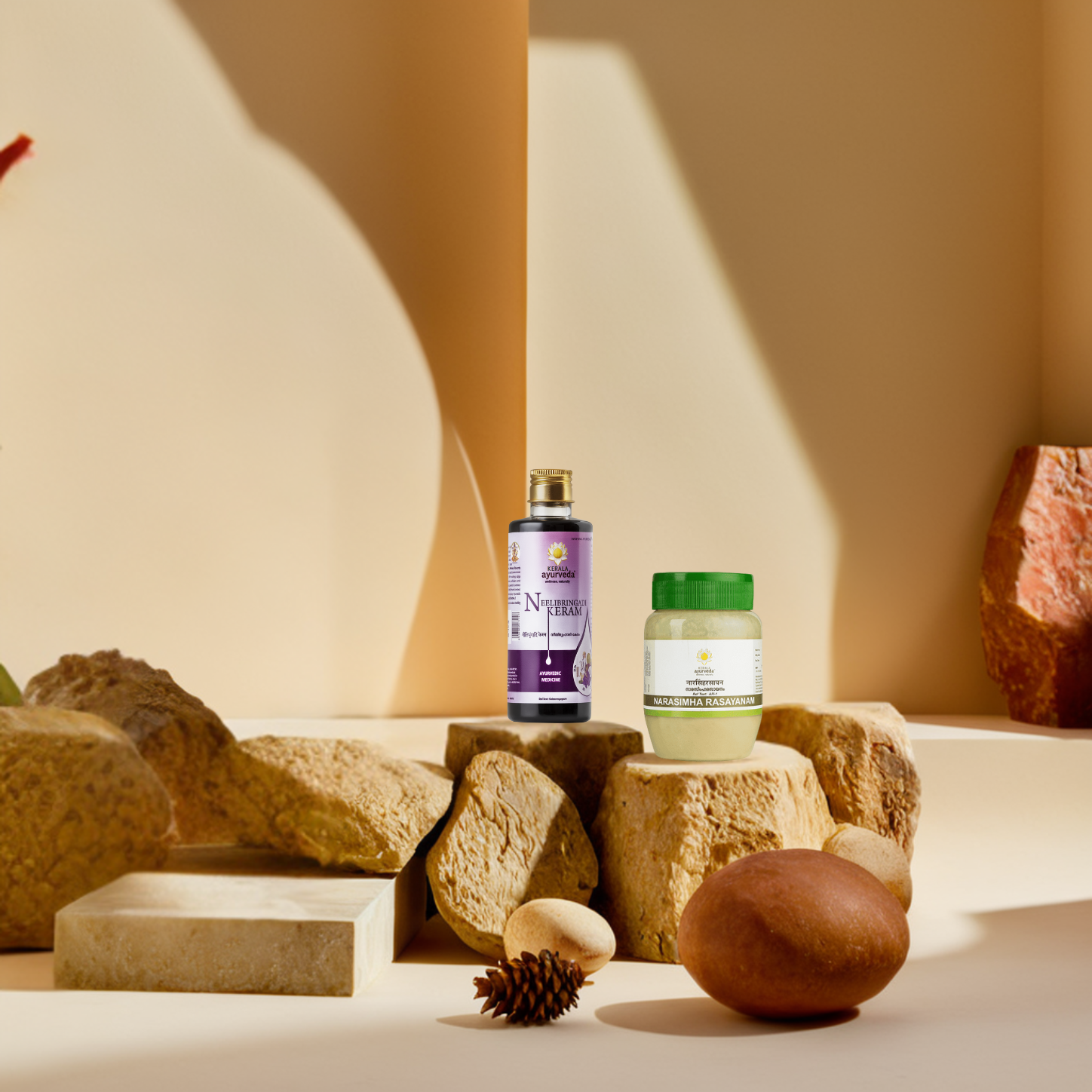Highlights
Ayurveda is a complete medical science that treats illnesses at their root.
Ayurveda offers mainly two types of treatments:
- Shamana Chikitsa: Shamana Chikitsa involves the administration of herbal medicines to subside the symptoms.
- Shodhana Chikitsa: Shodhana Chikitsa refers to the purification of the body from within using various procedures that combine to form Panchakarma.
As per the Ayurvedic texts, the disease cured by Shodhana or Panchakarma Therapy will never recur, whereas the conditions treated with Shamana therapy may recur.
What is Panchakarma in Ayurveda?
Panchakarma Treatment is a specialized Ayurvedic therapy that involves the internal purification of the body through five specially designed procedures. One key characteristic of Panchakarma is that it can provide both prevention and cure for various health concerns. It's not just a bio-purifying therapy, Its broad therapeutic effects can also deliver visible relief from many diseases.
What are the 5 Panchakarma Procedures?
Panchakarma treatments involve:
- Vamana (Therapeutic Emesis)
- Virechana (Purgation Therapy)
- Vasti (Therapeutic Enema)
- Nasya (Errhine Therapy)
- Raktamokshana (Blood-letting)
Ayurvedic Panchakarma Treatment & How It Works
The healing process of Ayurveda is a little different from modern medicine.
Ayurveda is based on the principle of promotion of health and prevention of illness rather than disease elimination. Ayurveda focuses on maintaining health by balancing the three physiological forces of the body (Doshas) - Vata, Pitta , and Kapha.
The balance of these forces ensures good health. If the balance is disturbed, toxins may accumulate in the body. These toxins can create blockages in the functions of various body systems, including the digestive, circulatory, and nervous systems. This can lead to disease.
Panchakarma therapy can help the body eliminate wastes that have accumulated and lodged in the body. When these toxins are removed through panchakarma, the body can regain its original strength and normal functions.
The Process of Panchakarma Therapy
The complete Panchakarma process involves three stages: Purvakarma, Pradhana Karma, and Paschat Karma.
Stage 1: Purvakarma
For a better outcome of Panchakarma treatment, it is essential to prepare the body before the main purification procedure. For this, we have three pre-purification measures –
- Deepana-Pachana
- Snehana
- Swedana
Deepana-pachana means oral administration of digestive herbs to increase Agni (the digestive fire) and liquefy the toxins so they can be removed easily from the body.
Snehana means Oleating the body. There are two types of Snehana- Internal and External.
- Internal Oleation is the administration of medicated ghee internally. Ghee is administered in increasing doses for 3-7 days. The type and dose of medicated ghee depend upon the disease condition and nature of the patient.
- External Oleation means body massage using specific oils. It can be done for the entire body or just specific parts. Oils are selected as per the disease condition.
Oleation helps the toxins to move toward the gastrointestinal tract. It also softens the superficial and deep tissues and nourishes the nervous system.
Depending on the individual condition, Dhanwantharam Thailam and Sahacharadi Thailam are used for oleation.
Swedana is inducing sweat with the help of steam. It is done by making the person sit in a chamber filled with steam from herbal decoctions. It detaches toxins from tissues and expels them through the tiny pores of the skin along with the sweat.
Stage 2: Pradhana Karma - The Main 5 Panchakarma Therapies
We can understand these 5 purification techniques through the following table:
Vamana is helpful in treating Kapha dominant diseases, and the purification is done through emesis. Includes the administration of herbal medicines to induce vomiting to eliminate toxins through the mouth.
Virechana therapy is beneficial mainly for Pitta diseases but is also useful in Kapha and Vata. Inducing controlled loose motions does purification by eliminating toxins.
- The most popular herbal preparation used for Virechana includes Avipatti Powder or Avipathi Choornam. Both are meant for the comfortable completion of the virechana procedure.
Vasti is the mother of all panchakarma procedures. It purifies through the colon and rectum. Basti is of two types:
- Anuvasana: Enema of medicated oils.
- Asthapana: Enema of decoctions.
Nasya can be done by putting medicated oils through the nose. The most widely used oil for Nasya karma is Anu Thailam. It is easily instilled in the nostrils. Many patients use it daily at home.
Raktamokshana is the removal of impure blood. It is done by using Leech or directly puncturing the veins.
Specific uses of Panchakarma Processes:
Vamana -
- Chronic asthma
- Diabetes
- Chronic cough & cold,
- Chronic indigestion
- Allergies
- Skin diseases
Virechana -
- Chronic Fever
- Diabetes
- Skin disorders such as Vitiligo and Psoriasis
- Neurological diseases like Paraplegia, Hemiplegia, and paralysis
- Joint disorders
- Digestive disorders like constipation and hyperacidity.
- Headaches.
- Elephantiasis
- Gynecological disorders.
Vasti -
- Degenerative diseases
- Ankylosing spondylitis
- Lumbar spondylitis
- Skin diseases
- Osteoporosis
- Sciatica
- Digestive diseases
Nasya
- To improve eyesight
- Ear, Nose, and Throat diseases
- To improve memory
- Trigeminal neuralgia
- Bell's palsy
- Headache
- Migraine
- Nasal polyps
- Breathing problems
- Hair falling
- Premature hair-greying
Raktamokshana
- Skin Diseases like acne, urticaria, psoriasis, and eczema
- Non-healing wounds
- Pain management
- Sciatica
- Elephantiasis
- Varicose veins
- Arthritis
Stage 3: Paschat Karma
This is a post-purification regime to restore digestive power and bring normalcy to the body. It is done through specific diet, lifestyle management, rejuvenating medicines, and specific herbal preparations. It includes -
- Sansarjan Karma: It is a specific diet protocol aiming to gradually increase diet from liquids to semi-solids to a normal diet.
- Administration of Rasayan: taking a rejuvenating medicine as per your condition is used to help physically restore the body.
- Shaman Chikitsa: adding appropriate ayurvedic medicine may help further reduce the disease symptoms.
Who Can Undergo Panchakarma?
All adults between 18-70 years of age can undergo Panchakarma.
How Much Time is Required for Panchakarma Therapy?
Generally, 21 days are required for a complete panchakarma treatment. Although it can be customized as per your requirement.
How Often Should We Go for Panchakarma Treatment?
Panchakarma is usually recommended during a change of season. Generally, we can take 2-3 complete Panchakarma sessions in one year.
How to Know Which Panchakarma Procedure is Useful for a Patient?
Planning a panchakarma treatment depends on many factors-
- Age
- Body structure
- Dietary habits
- Living environment
- Weather
- Dosha status of the body
- Type of illness
- The medicines you are taking
Let your doctor decide which purification technique would be the best for you.
Other Popular Ayurvedic Kerala Panchakarma Techniques
- Udvartana: Massaging the body using herbal powders. It helps in weight loss.
- Shirodhara: Pouring warm oils directly on the forehead. Useful in stress and anxiety. It improves sleep quality and memory.
- Shiropichu: Put oil-soaked cotton over the head.
- Shirovasti: Oil is poured and kept over the head inside a specifically designed cap.
- Kati Vasti: Oil is poured and let sit over the back region. It helps in relieving back pain.
- Janu Vasti: Oil is poured and retained over the knees. It helps in reducing knee pain and swelling.
- Hridya Vasti: Oil is kept over the cardiac region. It helps to strengthen the heart.
- Griva Vasti: In patients having neck pain medicated oil is poured and retained over the back of the neck region. This has been proven very effective in neck pain and cervical spondylosis.
- Akshitarpan: Oil is retained over the eyes. It improves eyesight, removes dark circles, and helps in preventing cataracts.
- Potli Sweda: Warm small herbal pouches are applied over the body.
- Uttara Vasti: Medicinal oil or ghee is administered through urethral or vaginal routes. It has been proven very effective in managing infertility issues in both males and females.
- Njavarakizhi (Shashtikashali pinda swedam): “Njavara” means “Shashtika Shali”, a type of rice, and “Kizhi” means poultice or a cloth bag. Njavarakizhi is a refreshing ayurvedic massage using a small cloth bag containing cooked rice mixed with herbal powders. This bag is dipped in medicated oil and applied to the body. It induces sweat. It is beneficial in Vata problems, neurological diseases, and joint pain.
- Pizhichil (Thaila Dhara): It combines Snehana and Swedana. Pizhichil means “to squeeze.” In this procedure, a special linen cloth is dipped into warm medicated oil and squeezed rhythmically over the patient's diseased areas. It improves blood circulation, relieves stress, and is helpful with neurological problems.
General Instructions During Panchakarma Treatment
During panchakarma treatment, the following rules are recommended-
- Use only warm water to drink and bathe.
- Avoid sexual intercourse.
- Avoid sleeping during the day.
- Avoid using air-conditioners.
- Avoid late-night working.
- Avoid heavy food.
- Avoid stress
- Do not do heavy exercise.
- Always keep your head and ears covered with a cotton cloth.
Benefits of Panchakarma Therapy
The topmost benefit of panchakarma is to get rid of chronic illnesses through internal purification. Apart from treating specific illnesses -
- It eliminates toxins accumulated in the body.
- It recharges the body, mind, and soul.
- It balances the Tridosha -Vata, Pitta, and Kapha to maintain equilibrium in the body.
- It helps in reducing physical and mental stress.
- It improves digestion.
- It helps in providing glowing skin.
- It improves immunity and strength.
In short, Panchakarma Therapy is the best option if you want a long-term cure for your illness.
Practical uses of Panchakarma Therapy
Panchakarma therapy is becoming increasingly popular since it is an efficient way to cure several chronic conditions. It is helpful even in managing auto-immune diseases, hormonal problems, degenerative diseases, and other problems for which other types of treatments are ineffective. Ayurvedic doctors recommend Panchakarma Treatment for a wide variety of health conditions:
- Obesity.
- Joint Pain.
- Stress, anxiety, and depression.
- Respiratory problems like asthma.
- Allergies.
- Neurological problems like Paralysis, Cerebral Palsy, and Facial Palsy.
- Digestive problems like irritable bowel syndrome.
- Polycystic Ovarian Diseases.
- Infertility.
- Skin diseases like psoriasis, eczema, and vitiligo.
Which panchakarma procedure is the best for weight loss?
Vasti and Virechana are commonly used for weight management programs. There is a special Basti named “Lekhana Basti” which is effective in reducing extra weight. It is prepared after careful assessment of the individual.
Panchakarma for Healthy Individuals
Ayurvedic therapies aim not only to treat diseases, but also to maintain the health of a healthy individual. Likewise, Panchakarma is not meant only for treating diseases, it is equally useful for healthy individuals. Panchakarma treatment is believed to help cleanse the body of impurities that can lead to disease.
Panchakarma improves health and promotes the self-healing power of the body. It improves the functioning of all the organs and helps achieve sound mental health.
In healthy individuals, Virechana Therapy is the most popular. This provides a feeling of complete detoxification. It should always be done under an expert’s supervision.
What happens after panchakarma?
Right after the completion of panchakarma treatment, most patients explained the experience as blissful. They feel refreshed and energetic. A comforting lightness in the body can also be expected. All patients are expected to follow a specific diet and lifestyle to enjoy the benefits for a longer duration.
Are there any side effects of Panchakarma Therapy?
Most of the patients do not feel any kind of side effect. A few may feel some minor problems like mild gastric upset, rise in body temperature, general weakness, headache, and mild insomnia. As panchakarma helps balance hormones, mental symptoms like mild depression have also been reported in a few patients. These effects are self-limiting and do not need any intervention or medicine.
Always keep in mind that panchakarma treatment is to be done under the supervision of a qualified ayurvedic physician only. Panchakarma therapy needs a proper assessment and planning by an expert. If inexperienced hands do it, it may cause some problems.
In what conditions Panchakarma is not to be done?
Panchakarma should be avoided in:
- Pregnancy
- During periods
- Lactating mothers
- HIV positive patients
- Acute infections like dengue fever, typhoid, etc.
- Patients with very high blood pressure.
- In severe heart problems like congestive heart failure, angina pectoris, etc.
Common Myths and Facts about Panchakarma Therapy
Myth: Ayurvedic oil massage is a complete panchakarma treatment.
Fact: Abhyanga is very popular as an Ayurvedic massage and is often mistaken as a complete panchakarma. Oil massage is a small preparatory procedure and is not complete panchakarma therapy.
Myth: Panchakarma therapy can cure all my diseases.
Fact: Panchakarma treatment effectively treats many illnesses. Like any other treatment modality, it also has its limitations. It does not guarantee a sure-shot treatment for all diseases.
Myth: Panchakarma can't be done in children.
Fact: Many procedures are contraindicated in children but not all. Panchakarma therapy like shiropichu, njavara theppu, is very useful in a few diseases in children. It is mainly recommended for cerebral palsy, attention deficit hyperactivity disorder (ADHD), mental retardation, etc. It needs to be done strictly under expert supervision.
Myth: We need to stay in the hospital for panchakarma treatment.
Fact: The patient is advised to undergo panchakarma treatments while in the hospital. This ensures proper treatment. We can also do it at an outpatient level where you visit the center at a specific time to take your session and then go home again. It requires certain precautions to be followed.
Myth: Purgation during Virechana (Purgation) leads to dehydration.
Fact: Virechan rarely causes dehydration as it is a planned purgation supervised by experts. Water loss will occur, but if you follow your doctor's instructions, dehydration will not occur.
Myth: I cannot take Panchakarma treatment along with allopathic medicines.
Fact: We can do Panchakarma even if you are on allopathic medicines for any health issue. You just need to discuss with your Ayurvedic doctor the medicines you are taking. Your Ayurvedic doctor will advise the therapies as per your condition.
Myth: Panchakarma is effective only in joint pain.
Fact: Many people see panchakarma as an oil massage, effective only for joint pain. The fact is that panchakarma is useful in almost all kinds of chronic diseases. Skin diseases and musculoskeletal diseases remain at the top of the list. It is also effective for diabetes, psychological problems, digestive issues, kidney diseases, and heart problems.
Key Takeaways
Panchakarma is one of Ayurveda's most valuable gifts to humans. If you are looking for long-term and permanent relief from your health issues, panchakarma treatment is a no-brainer. It helps in the overall cleaning of the body. It energizes you by rejuvenating the body tissues from within. Take panchakarma treatment today by consulting an Ayurvedic doctor near you.




